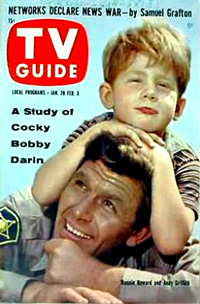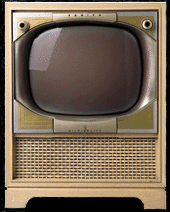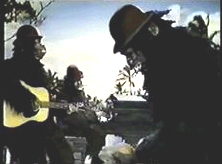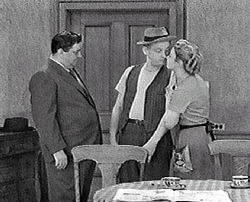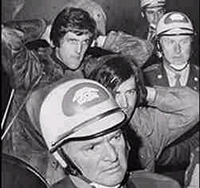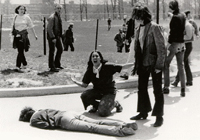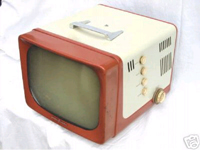|
Early Television Programming "Change happens exponentially." freedomisknowledge.com
The variety of evening television programs were increasing to meet the demand of a growing population of viewers. America was falling in love with the fresh, fun, and dynamic personalities who were appearing on the new medium, creating a natural evolution for the console television set to replace the radio as an integral part of providing free entertainment for the home, a new focal point for the family to gather around.
While the small kitchen television set had yet to be developed, the fast food market had galloped to the rescue of hungry viewers by giving birth to the pop-in-the-oven frozen "TV Dinner." Now Americans could graze while watching their favorite TV show. People in their 50's or older will remember how funny many of the comedians were that appeared on early television, their routines so inventive they would receive belly laughs from live audiences and viewers, their shows on for years. They never needed the prop of a faked recorded laugh common today with almost all television sitcoms, the audio edited with a computerized, digital-laugh track designed to tell you where you should laugh in case you don't. These vintage comedians proved again that "Necessity is the Mother of Invention," getting laughs without the crutch of shock-talk that marks modern-day funny comedians. Yesterday's television comedians never relied on vile and offensive language, obvious sexual innuendo, or bathroom humor to shock their audiences into submission. On their own they were very talented, creative, and innovative personalities. You could walk up to almost anyone you knew, talk about one of these early comedians, and everyone would know who you were talking about. You could share most any of their hilarious routines with friends or workers without worrying if a child was present or if you were violating company policy.
These comedic masters included the likes of Jackie Gleason, Jack Benny, Bob Hope, Jerry Lewis, Sid Caesar, Milton Berle, Steve Allen, Jack Parr, Ernie Kovac, George Gobel, Red Skelton, George Burns, and later Peter Sellers to name just a few. These great comedians set the American standard for humor, fun, and laughter that was heard around the world. In the end, they helped everyone to forget their troubles in a time when innocence was not a liability, but an attribute.
Television was fun, loved, and non-rated because it
didn't have to be. Click
here for a virtual list of the amazing amount of television
shows that were a part of classic, broadcast television programming
without the need for a regulating rating system. You can also see
a listing of popular television programs from the 1930's through
today by visiting the site Wikipedia's Free Encyclopedia's
listing for the Years
of Television. As millions of Americans ate their dinners watching extremely popular television shows, one bright star on almost everyone's lips was the name, Jackie Gleason. Few dared to plan anything on the evening that Jackie Gleason's "Honeymooners" was on live in homes across America.
Here are a few examples of the show titles that ran in the late 50's and 60's on broadcast television:
A new kind of television programming was also coming of age that would cause neighbors and friends to gather together to surround the television screen on lazy Sunday afternoons. They would be accompanied by bowls of muchies and a variety of cold drinks to watch their favorite players of NFL football in new "living color." This event happening in neighborhoods across the county would lead to creating one of the grandest TV events of our time, the Superbowl, which has amazingly grown in popularity right into today's culture. Corporations would suddenly spend millions of dollars to advertise their product to buy a blink-of-an-eye in time. Today's Superbowl ad is worth around 2.5 million dollars for 30 seconds of time, or about $83,000 a second.** America's new love affair with football and other live national sporting events, such as the Winter and Summer Olympics, would give birth to the need for a large-screen television that would allow more people to gather round a single set. This would create a huge audience that would demand perfection from diva sport stars, voting on them with the turn the turn of a dial. Where baseball, football, and basketball players had earned tens-of-thousands of dollars a season, their new salaries would soon make them millionaires. And not for the length of a career, but for the length of a single contract.
America was entering the decade of the 1970's as television evolved into presenting more sophisticated programming. Around the same time violent protests on American soil over the Vietnam war were rapidly causing families to feel uncomfortable for the first time with their home television viewing. "A hot war on a cool media" was not sitting well with millions of viewers. The antiwar protesters were quickly learning how to use the half-hour evening television news to promote their personal hate-America agendas with chants, riots, and song (Compliments of CountryJoe.) Thousands of body bags came home in living color on a screens that were suddenly used for propaganda by savvy anti-war groups. Young yuppie activists and opportunists against the war made it their business to promote their hate by spitting on returning American servicemen and burning the country's flag on the steps of court houses and in the nation's capital. This caused laws to be changed that would allow the flag to be desecrated in public as a form of free speech, past Veterans of Foreign Wars horrified at the liberal ruling.
Activists formed groups that were assigned to college campuses to stir up students, raising up home-made looking signs with screaming voices when they would see television cameras near-by. Activists also encouraged students to burn their draft cards and to break the law, arranging violent confrontations in front of the cameras. This violence reach a fever pitch in an atmosphere that finally resulted in students being killed in front of television cameraman via the famous Kent State incident. Activists were overjoyed, realizing they were winning the media image war. Many older Americans and Vets saw the activists as spoiled children taking everything they needed from the superstructure that had been built by them. . . food, water, electricity, shelter with a bathroom, a couch with a television, and a bed to share sex, all part of the live-in commune environment. Too many activists had nothing to lose and everything to gain, having wanted nothing since birth and growing up in wealthy American homes. This had a direct effect on changing the social environment of America. The country was slowly drifting away from the foundation of the family unit after a decades-long habit of gathering around the old wooden television console in the living room. America was losing its innocence, entering into the start of a long and very slow downhill spiral into the decay that had marked so many other successful and arrogant societies throughout the history of civilization. Ironically, it would be television itself that would rip the country apart years later as spin masters and agenda-driven, power-hungry media giants would shift the message of television from mainly an entertainment source to a full-blown propaganda machine. So it was natural again, as you read in the beginning of this chapter, that the role of the console television would change again, this time evolving into smaller screen sizes that would accommodate dysfunctional and separated families. Multiple sets would soon find themselves located throughout the home in kitchens, enclosed porches, and bedrooms, while the new, all-purpose family room made space for the first large-screen televisions. Families had evolved to individuals watching network dramas and playoffs of icon sport teams in different rooms. It was also a perfect time for the addition of a new video source, the prerecorded movie rental tape with titles such as Star Trek the Movie and Silent Running. It was one of the first alternative viewing sources that could be played back using a new concept called Time-Shifting, providing the first add-on component for television . . . the VCR. America was on its way down the road to discovering today's wide-screen and HDTV generation of television sets, now only twenty years away in the future. ___________________________________
Go to Chapter 4, "Audio
Copyright freedomisknowledge.com 2007-2008 |
|
Index
|
